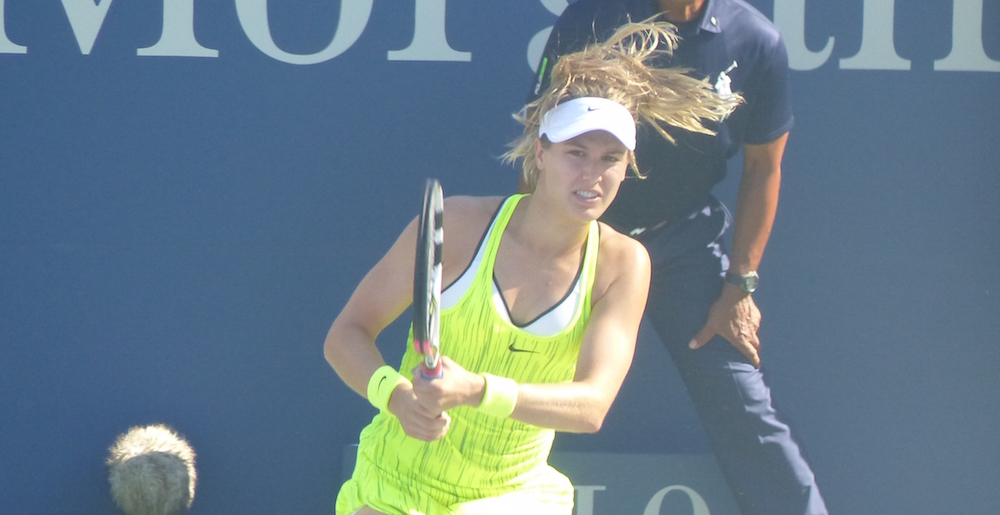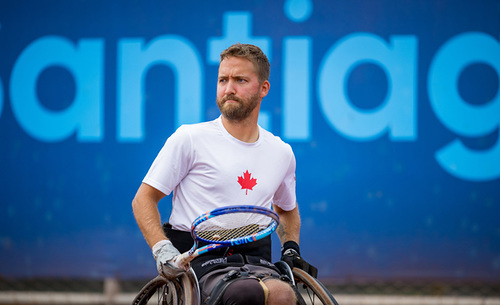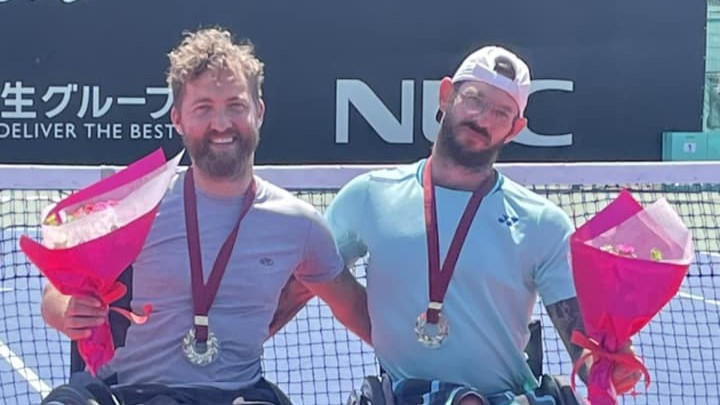
For all the Genie Bouchard fans out there who are looking for definitive answers about where she is now with her tennis, there were no new conclusions to be drawn after her 6-3, 3-6, 6-2 loss to Katerina Siniakova in the first round of the US Open on Tuesday.
Hard analysis of the match could point to a pair of forehand errors by Bouchard when she served at 3-4, 30-all in the first set. The first flew long and the second was into the net giving Siniakova the break and the separation she needed to go on and take the first set.
Bouchard picked up her play in the second set as the No. 72-ranked Czech lost a little something, enabling the Montrealer to level matters at a set apiece after an hour and 25 minutes.

At that point, Siniakova left the court for a bathroom break and Bouchard called for the trainer to have treatment for blisters on both feet – two separate medical timeouts – before play resumed 10 minutes later.
The early part of the third set was highly competitive with Siniakova needing seven break points before finally breaking Bouchard for a 2-0 lead. But Bouchard bounced straight back to even matters at 2-all before Siniakova gradually took control against a fading Bouchard to wrap up the match on the new Grandstand stadium in two hours and 14 minutes.
That wobble at 4-all in the first set and the dip over those final four games of the match proved to be the difference against a remarkably tough Siniakova. The 20-year-old Czech at least matched Bouchard in intensity and aggressiveness and had a bit of a secret weapon in her backhand – which she hits either inside/out or just plain down-the-line with accuracy and often with surprise.
“Many people say it’s my best shot so I keep working on it,” said the sympathetic Czech after the match.

Sinakova, who had not played since she reached the final of the WTA event on clay in Bastad, Sweden in July, explained that she just wanted to spend time at home in Hradec Kralove.
“I remember her but when I was playing juniors she was mostly playing the women’s tournaments,” she added about Bouchard. “So I knew her but I didn’t play against her in juniors.”
It was Siniakova’s first main-draw match win in three tries at the US Open and she was thrilled to play on the new 8,000-plus seat Grandstand.
The Bouchard take on the match was as follows, “I feel like I didn’t really play well. My opponent probably played really well and I tried my best. I fought my hardest but I wish I could have had better feeling kind of on the court and served better…things like that.”
She added, giving Siniakova her due, “I’d never played her so I didn’t know what to expect. I felt like she was really going after it and was very consistent while doing that. She played better than me today for sure.”

That last remark was typical of Bouchard’s candour during her post-match media conference.
In 2015 she entered the US Open on a disastrous 3-15 run, a year after she had reached the Wimbledon final and made it to No. 5 in the world.
Nothing has been quite the same since and clearly if Bouchard had solutions for her decline she would have implemented them and gotten back on track. The adversity has given her perspective and she offered a thoughtful analysis of her career evolution. “When I broke through I was the underdog a lot,” she said, “maybe a lot of the players didn’t know who I was or knew my game so well. That’s an advantage for any young player coming up – you can see that happen a lot. Obviously there’s that saying the ‘sophomore slump,’ things like that. It’s hard to maybe keep up really good results year-to-year. So I don’t know…it’s just the way it goes. I think it happens to a lot of players and it’s something that happened to me.
“I had amazing results in 2014 and it’s hard to have results like that every single year. I’m just working on what I can do to try to become as good as I can and have the results I want but it doesn’t always go your way.”
She offered no excuses for Tuesday’s performance, explaining about the blisters on both feet, “I did not have them before (the match). Sometimes when it’s really hot I sweat a lot so my socks get really wet. Just that friction causes them to get a big sore. I’ve had it in a couple of matches in the past. I feel like on hard court, it’s a little bit worse sometimes. I felt it a bit but it didn’t affect the match.”
She then got the only laugh of the media conference when asked if it was unusual to have blisters on both feet, answering, “a little bit but I use both my feet equally.”
The American media, not surprisingly, went after the lawsuit that Bouchard has pending against the United States Tennis Association over the late-night fall and subsequent concussion in the locker room a year ago.
“Obviously coming back here I had mixed emotions,” she said. “It’s hard not to think about what happened last year. But since I’ve been here I’ve been forcing myself to just focus on the positive. I’ve also had great memories at the US Open – I played really well last year and did well the year before even – so I was just trying to think about that and stay positive.
“It’s one of those things when you try to mentally block something out – that’s what I was trying to do all week. I think I was able to. There’s a lot going on so I was able to focus without having to worry about that as well.”
Much as she downplayed any distraction the 2015 US Open might have been, there was a sense that at least a small part of her is still not over the incident, particularly being back at the ‘scene of the crime.’
The USTA has said that its efforts to settle the matter have been rebuffed and suggested that Bouchard would be better to focus on her tennis.
After saying matter-of-factly that she felt she had been treated “well” by US Open officials this year, Bouchard said in response to the USTA suggestions about her focus, “I am 100 per cent focused on tennis and I have lawyers who are working on the case, so I don’t think about it very often at all – maybe once a month when they call me. It’s not a factor in my life. I just know it’s going on in the background. I’m disappointed in what happened so I have to fight for what I think is right.”

The loss to Siniakova should not be too devastating to her current No. 39 ranking. She had 240 points (reaching the round-of-16) from last year to defend and will likely not fall to much worse than No. 45 in the post-US Open rankings.
Bouchard’s next event is the National Bank Cup in Quebec City the week after the US Open. She insists that she is still as motivated as ever and said summing up her present state of mind in relation to her sport, “every time I step on the court I love tennis, I love playing tennis. I love the feeling of hitting the ball and competing and having that competition and trying to win. When I was out for a couple of months last year I realized how much I love it and missed it when I was forced not to play. I wouldn’t want to be doing anything else.”
Raonic, Pospisil to Grandstand

Vasek Pospisil and Milos Raonic will play their second-round matches back-to-back in the new Grandstand Stadium beginning at 11 a.m. (ET) on Wednesday.
Pospisil faces No. 23 seed Kevin Anderson, who was bothered by knee and shoulder issues early in the year and then had ankle surgery in March. Since returning at the clay court event in Madrid in May, his match record is a modest 9-12 and he has seen his ranking fall to No. 35 from a high of No. 10 in October 2015.
Anderson had his best US Open a year ago when he reached the quarter-finals before losing 6-4, 6-4, 6-0 to Stan Wawrinka.
He won his only previous meeting with Pospisil – 7-5, 7-6(4) in Rome in 2014.

Pospisil was pleased with his play in a win over lucky loser Jozef Kovalik of Slovakia on Monday but will have to raise his game a level against the 6-foot-8 South African who is now 30 years old.
As for Raonic, playing Harrison will be old hat. They go back to their junior days. But while Raonic has reached a career high of No. 4, Harrison, a year younger at 24, achieved a best ranking of No. 43 in 2012. Since then, the Floridian, once viewed as the next great player of American tennis, fell as far as No. 197 in 2014.
But he has shown considerable improvement lately and said on Monday about the second-round match-up with Raonic, “I’m not trying to play above my level in this next match (versus Raonic). I’m going to go out there and do all the things that have put me in the position to play these top players over the last two or three months. I know it’s going to be good enough to put me in a position to win. When you start playing Top 5, Top 10 players knowing you’re going to be in position is different than executing. Because they know they’re going to be in position too, it’s just part of playing at a high level. I fully expect it, with the way he serves, to come down to a couple of points – a break point early in a set or a (tie)breaker late in a set. I’m going to have use some of the experience I’ve gotten through things this summer to make sure I stay calm, execute as best I can. We obviously have both developed different parts of our game the last couple of years since we played last (2012). I still know a couple of his tendencies and I’m sure he knows a couple of mine. We’ll try to do our best to exploit each other’s weaknesses.”
Harrison, a qualifier, currently ranks No. 120 and said about qualifying for a Grand Slam that it’s much better because you don’t immediately have to go into playing matches as at most regular events. Instead you get time off between qualifying and the main draw and in between rounds.
US Open last point

There’s usually a break between the afternoon and evening sessions in Arthur Ashe Stadium. This group of ushers took advantage of that time to get a little relaxation on the steps leading into the stadium.


